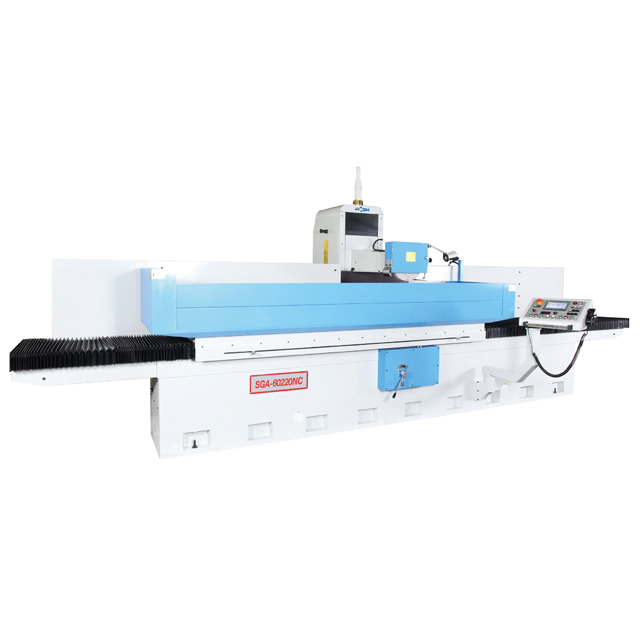Views: 5 Author: JSC Publish Time: 2025-03-19 Origin: Site
A surface grinder is an essential tool in high-precision machining, designed to remove material from a workpiece using abrasive grinding wheels. This machine excels in providing smooth, flat surfaces, which is particularly crucial in industries that require exacting standards such as aerospace, mold making, and precision engineering.

Surface grinders come in various types, including manual, automatic, and CNC models. The fundamental function of a surface grinder is to achieve a finely ground surface, often with tight tolerances that are difficult to achieve with other machinery.
The high-precision surface grinding process relies on the precision of the machine’s construction, the grinding wheel, and the technique used. Key factors that contribute to the precision of a surface grinder include:
Grinder's Stability: The structure of the machine, such as its base and table, must be extremely stable to avoid any vibrations during grinding.
Advanced Control Mechanisms: Modern CNC surface grinders offer high levels of automation and control, using digital readouts (DROs) and feedback systems to ensure consistency in machining.
Precision Grinding Wheels: The selection of the correct grinding wheel is crucial for achieving the desired surface finish and tolerances.
Coolant and Lubrication: Proper coolant flow is essential in controlling temperature during grinding, ensuring that the material remains cool and preventing thermal damage or warping.
Table Movement and Feed Rate: The movement of the grinding table is finely controlled, often with micron-level accuracy, to ensure the surface of the workpiece is ground to the required flatness.
Surface grinders play a critical role in various industries, providing precise and consistent surface finishes. Some of the key applications include:
· Aerospace Engineering: Surface grinders are used to finish components like turbine blades, aircraft landing gear parts, and other critical components where precision is paramount.
· Mold Making: In mold making, precision grinding is essential to achieving the fine surface finishes required for high-quality mold impressions.
· Automotive Industry: Surface grinders help in producing components like brake discs, camshafts, and valve seats with tight tolerances and smooth finishes.
· Medical Devices: Precision ground parts such as implants, surgical instruments, and other critical components rely on surface grinding for both finish and tolerances.
Accuracy: Capable of achieving tolerances within a few microns, surface grinders are indispensable for industries requiring ultra-precise machining.
Versatility: Surface grinders can handle a wide range of materials, including ferrous and non-ferrous metals, ceramics, and plastics, depending on the grinding wheel used.
Surface Finish: Surface grinders can achieve different types of surface finishes ranging from rough to mirror-like finishes, depending on the grit and type of grinding wheel used.
Automation: Many modern surface grinders, especially CNC models, offer automated processes that reduce human error and increase repeatability for mass production.
To maintain the high-precision capabilities of a surface grinder, it is essential to implement regular maintenance routines. Key steps include:
· Regular Lubrication: Ensure that the machine's moving parts are regularly lubricated to prevent wear and tear and maintain smooth operation.
· Check Grinding Wheel Condition: Over time, the grinding wheel may become worn, affecting the surface finish. Regular inspection and reconditioning of the wheel are necessary.
· Alignment Checks: Periodic checks of the machine’s alignment and leveling are essential to ensure the precision of the grinding process.
1. What is the main function of a surface grinder?
A surface grinder is designed to produce smooth, flat surfaces on metal or other materials, typically by using a rotating abrasive wheel. It is essential for applications requiring high precision, such as mold making, aerospace, and automotive industries.
2. How does a surface grinder achieve precision?
Surface grinders achieve precision through a combination of a stable machine structure, controlled feed rates, accurate table movements, and the use of high-quality grinding wheels. Coolant systems also play a crucial role in maintaining optimal operating temperatures.
3. What industries benefit from using surface grinders?
Surface grinders are widely used in industries such as aerospace, automotive, mold making, and medical device manufacturing, where precision and surface finish are critical.
4. What is the difference between a CNC surface grinder and a manual one?
CNC surface grinders are computer-controlled, offering higher precision, repeatability, and automation, making them ideal for mass production. Manual surface grinders require skilled operators and are more suited for smaller batches or custom work.
5. How do you choose the right grinding wheel for a surface grinder?
The choice of grinding wheel depends on the material of the workpiece, the desired finish, and the machine's specifications. Factors like grit size, bond type, and abrasive material all influence the grinding performance.
Call to Action:
Looking for a reliable surface grinder? Contact us today to explore our extensive range of Precision Lathe Reliable Pergormance and find the perfect solution for your production needs.
Phone: +86-13905278551
E-mail: jeff@jscmachinery.com
WhatsApp:+86-13905278551